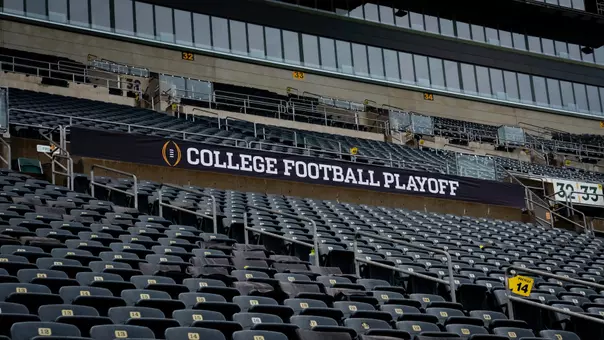
Photo by: Samuel Marshall
Season In Review: Receiver/TE
01/10/19 | Football, @GoDucksMoseley
Oregon's pass catchers had an inconsistent season as a group, but the exception was Dillon Mitchell, who set a new UO single-season record for receiving yards before turning pro.
Reviewing Oregon's 2018 season and looking ahead to spring drills.
DEPTH CHART
WR: Dillon Mitchell, Jr.; Bryan Addison, Fr.; Daewood Davis, RFr.; Alfonso Cobb, So.; JJ Tucker, Fr.; Korbin Williams, Fr.; Noah Holmes, RFr.
SLOT: Jaylon Redd, So.; Demetri Burch, RFr.; Justin Collins, So.; Tabari Hines, Gr.; Jack Vecchi, RFr.; John Keller, Jr.
WR: Brenden Schooler, Jr.; Johnny Johnson III, So.; Kyle Buckner, Jr.; Isaah Crocker, Fr.; Tevin Jeannis, Fr.; Vincenzo Logan, Fr.
TE: Jacob Breeland, Jr.; Ryan Bay, Jr.; Kano Dillon, Gr.; Hunter Kampmoyer, So.; Cam McCormick, So.; Matt Mariota, Jr.; Spencer Webb, Fr.
Starters: It's a befuddling irony that, in a season marked by inconsistent hands from UO pass catchers, the Ducks saw their single-season record for receiving yards fall. But that was the case in 2018. Dillon Mitchell had 70 yards and the only touchdown of Oregon's Redbox Bowl win over Michigan State, thus finishing his junior season with a UO-record 1,184 yards. That came on 75 receptions, and resulted in 10 touchdowns — remarkable totals given that Mitchell had a grand total of six receptions in Oregon's three nonconference games, and just one in the Civil War. He was never better than in the Ducks' overtime loss to Stanford, catching 14 passes for 239 yards. Much was made of Oregon's reliance on Mitchell in the passing game; he caught 30.5 percent of the Ducks' total receptions in 2018. But, some context: When Samie Parker set the UO single-season record of 77 catches in 2003, that was 31.2 percent of the Ducks' receptions that year. And when Jeff Maehl tied Parker's record in 2010, his 77 receptions were 31.1 percent of Oregon's team total. The bottom line: When you have an elite receiver, you throw to him a lot. (An exception was 2014, when Byron Marshall's 74 receptions were just 22.7 percent of Oregon's total. That team also had Darren Carrington II, Devon Allen, Dwayne Stanford, Pharaoh Brown, Keanon Lowe and Charles Nelson. No wonder they went to the natty!)

The Ducks' most consistent complementary threat was sophomore Jaylon Redd. He had a breakout season, catching 38 balls for 433 yards and five touchdowns. His fancy footwork on a touchdown pass from Justin Herbert was among the biggest highlights of Oregon's overtime victory over Washington. Beyond Mitchell and Redd, however, the Ducks' receivers and tight ends unfortunately were inconsistent this past fall. Johnny Johnson III slimmed down and looked ready to take a big step forward over the offseason, but after catching four TD passes in Oregon's three nonconference games, he didn't have another the rest of the season. Brenden Schooler started in that spot the latter half of the year, but he too struggled to hang on to the ball. At tight end, Jacob Breeland caught 24 balls, but a thumb injury early in the season hampered him. He reclaimed the starting job after sophomore Cam McCormick, who jumped to the top of the depth chart in preseason camp, suffered a leg injury in the season opener.

Reserves: Oregon's tight end depth came into play after McCormick's injury, and while Breeland dealt with the thumb issue. Ryan Bay started the Stanford game, and three others alongside Breeland in formations using two tight ends. Bay was an asset in the run game, less so as a receiver. Kano Dillon caught eight balls for 110 yards and two TDs as a graduate transfer, most memorably his touchdown catch after making the start at California. Hunter Kampmoyer had a single reception, like Bay contributing more as a blocker in the running game. Matt Mariota didn't crack the rotation offensively, but he was a mainstay all season with the punt return unit. Reserve receivers had a tough battle for playing time; graduate transfer Tabari Hines, transfer Justin Collins, Daewood Davis and Bryan Addison combined for six receptions. Three were by Hines, who left the team at midseason. Neither Kyle Buckner nor Alfonso Cobb finished with a catch, but each spent most of the season with the travel squad, the two non-scholarship guys edging out more highly touted young scholarship players in competition for those spots.
Developmental Squad: Though the door was certainly open for them to crack the rotation for games, true freshmen Isaah Crocker and JJ Tucker spent the season as redshirts with the scout-team offense. Crocker had some nice moments in the last few "Fast Friday" scrimmages for the developmental squad, perhaps feeling a sense of urgency to make an impression before a big group of freshman recruits arrives this year. At tight end, Spencer Webb flashed the potential to be a big-time threat in the pass game, while working to become a presence at the line of scrimmage as well. Among the walk-on receivers, Tevin Jeannis demonstrated his work ethic by being named scout-team player of the year on special teams.
ROB'S TAKE
SPRING PROJECTION
WR: Bryan Addison, RFr.; Daewood Davis, So.; Alfonso Cobb, Jr.; JJ Tucker, RFr.; Korbin Williams, RFr.; Noah Holmes, So.
SLOT: Jaylon Redd, Jr.; Demetri Burch, So.; Josh Delgado, Fr.; Justin Collins, Jr.; Jack Vecchi, So.; John Keller, Sr.
WR: Brenden Schooler, Sr.; Johnny Johnson III, Jr.; Kyle Buckner, Sr.; Isaah Crocker, RFr.; Tevin Jeannis, RFr.; Vincenzo Logan, RFr.
TE: Jacob Breeland, Sr.; Cam McCormick, RSo.; Ryan Bay, Sr.; Spencer Webb, RFr.; Hunter Kampmoyer, Jr.; Matt Mariota, Sr.
What to Watch: With Mitchell having declared for the NFL draft, that's well over 100 targets from the 2018 season that can be spread around to different receivers. So who gets them? Assuming that Redd solidified his hold on the slot position, that still leaves three spots on the depth chart looking wide open entering March. For Schooler and Johnson, the hope will be they can take a little break, clear their heads and put the inconsistencies of 2018 behind them; these are talented players, both hard workers, which made last fall all the more confusing to watch. A key guy this spring will be Addison. He was late arriving last summer, just before the start of preseason camp, and then sat out several weeks due to a suspension. But when Addison returned he seemed to have a new focus, and the coaching staff seriously considered burning his redshirt with a fifth game appearance in the Redbox Bowl, before ultimately opting to keep Addison out. He's a tall, rangy receiver who, along with Webb, has some of the best ball skills on the team already. The Ducks also should welcome McCormick back into the mix, after he was able to suit up for a couple of practices late in December. And freshman Josh Delgado enrolled this week for winter quarter, giving him a head start on classmates Mycah Pittman, JR Waters and Lance Wilhoite. All four — plus any other receivers the Ducks might add between now and next fall — have an excellent chance to earn playing time in 2019.
DEPTH CHART
WR: Dillon Mitchell, Jr.; Bryan Addison, Fr.; Daewood Davis, RFr.; Alfonso Cobb, So.; JJ Tucker, Fr.; Korbin Williams, Fr.; Noah Holmes, RFr.
SLOT: Jaylon Redd, So.; Demetri Burch, RFr.; Justin Collins, So.; Tabari Hines, Gr.; Jack Vecchi, RFr.; John Keller, Jr.
WR: Brenden Schooler, Jr.; Johnny Johnson III, So.; Kyle Buckner, Jr.; Isaah Crocker, Fr.; Tevin Jeannis, Fr.; Vincenzo Logan, Fr.
TE: Jacob Breeland, Jr.; Ryan Bay, Jr.; Kano Dillon, Gr.; Hunter Kampmoyer, So.; Cam McCormick, So.; Matt Mariota, Jr.; Spencer Webb, Fr.
Starters: It's a befuddling irony that, in a season marked by inconsistent hands from UO pass catchers, the Ducks saw their single-season record for receiving yards fall. But that was the case in 2018. Dillon Mitchell had 70 yards and the only touchdown of Oregon's Redbox Bowl win over Michigan State, thus finishing his junior season with a UO-record 1,184 yards. That came on 75 receptions, and resulted in 10 touchdowns — remarkable totals given that Mitchell had a grand total of six receptions in Oregon's three nonconference games, and just one in the Civil War. He was never better than in the Ducks' overtime loss to Stanford, catching 14 passes for 239 yards. Much was made of Oregon's reliance on Mitchell in the passing game; he caught 30.5 percent of the Ducks' total receptions in 2018. But, some context: When Samie Parker set the UO single-season record of 77 catches in 2003, that was 31.2 percent of the Ducks' receptions that year. And when Jeff Maehl tied Parker's record in 2010, his 77 receptions were 31.1 percent of Oregon's team total. The bottom line: When you have an elite receiver, you throw to him a lot. (An exception was 2014, when Byron Marshall's 74 receptions were just 22.7 percent of Oregon's total. That team also had Darren Carrington II, Devon Allen, Dwayne Stanford, Pharaoh Brown, Keanon Lowe and Charles Nelson. No wonder they went to the natty!)

The Ducks' most consistent complementary threat was sophomore Jaylon Redd. He had a breakout season, catching 38 balls for 433 yards and five touchdowns. His fancy footwork on a touchdown pass from Justin Herbert was among the biggest highlights of Oregon's overtime victory over Washington. Beyond Mitchell and Redd, however, the Ducks' receivers and tight ends unfortunately were inconsistent this past fall. Johnny Johnson III slimmed down and looked ready to take a big step forward over the offseason, but after catching four TD passes in Oregon's three nonconference games, he didn't have another the rest of the season. Brenden Schooler started in that spot the latter half of the year, but he too struggled to hang on to the ball. At tight end, Jacob Breeland caught 24 balls, but a thumb injury early in the season hampered him. He reclaimed the starting job after sophomore Cam McCormick, who jumped to the top of the depth chart in preseason camp, suffered a leg injury in the season opener.

Reserves: Oregon's tight end depth came into play after McCormick's injury, and while Breeland dealt with the thumb issue. Ryan Bay started the Stanford game, and three others alongside Breeland in formations using two tight ends. Bay was an asset in the run game, less so as a receiver. Kano Dillon caught eight balls for 110 yards and two TDs as a graduate transfer, most memorably his touchdown catch after making the start at California. Hunter Kampmoyer had a single reception, like Bay contributing more as a blocker in the running game. Matt Mariota didn't crack the rotation offensively, but he was a mainstay all season with the punt return unit. Reserve receivers had a tough battle for playing time; graduate transfer Tabari Hines, transfer Justin Collins, Daewood Davis and Bryan Addison combined for six receptions. Three were by Hines, who left the team at midseason. Neither Kyle Buckner nor Alfonso Cobb finished with a catch, but each spent most of the season with the travel squad, the two non-scholarship guys edging out more highly touted young scholarship players in competition for those spots.
Developmental Squad: Though the door was certainly open for them to crack the rotation for games, true freshmen Isaah Crocker and JJ Tucker spent the season as redshirts with the scout-team offense. Crocker had some nice moments in the last few "Fast Friday" scrimmages for the developmental squad, perhaps feeling a sense of urgency to make an impression before a big group of freshman recruits arrives this year. At tight end, Spencer Webb flashed the potential to be a big-time threat in the pass game, while working to become a presence at the line of scrimmage as well. Among the walk-on receivers, Tevin Jeannis demonstrated his work ethic by being named scout-team player of the year on special teams.
ROB'S TAKE
SPRING PROJECTION
WR: Bryan Addison, RFr.; Daewood Davis, So.; Alfonso Cobb, Jr.; JJ Tucker, RFr.; Korbin Williams, RFr.; Noah Holmes, So.
SLOT: Jaylon Redd, Jr.; Demetri Burch, So.; Josh Delgado, Fr.; Justin Collins, Jr.; Jack Vecchi, So.; John Keller, Sr.
WR: Brenden Schooler, Sr.; Johnny Johnson III, Jr.; Kyle Buckner, Sr.; Isaah Crocker, RFr.; Tevin Jeannis, RFr.; Vincenzo Logan, RFr.
TE: Jacob Breeland, Sr.; Cam McCormick, RSo.; Ryan Bay, Sr.; Spencer Webb, RFr.; Hunter Kampmoyer, Jr.; Matt Mariota, Sr.
What to Watch: With Mitchell having declared for the NFL draft, that's well over 100 targets from the 2018 season that can be spread around to different receivers. So who gets them? Assuming that Redd solidified his hold on the slot position, that still leaves three spots on the depth chart looking wide open entering March. For Schooler and Johnson, the hope will be they can take a little break, clear their heads and put the inconsistencies of 2018 behind them; these are talented players, both hard workers, which made last fall all the more confusing to watch. A key guy this spring will be Addison. He was late arriving last summer, just before the start of preseason camp, and then sat out several weeks due to a suspension. But when Addison returned he seemed to have a new focus, and the coaching staff seriously considered burning his redshirt with a fifth game appearance in the Redbox Bowl, before ultimately opting to keep Addison out. He's a tall, rangy receiver who, along with Webb, has some of the best ball skills on the team already. The Ducks also should welcome McCormick back into the mix, after he was able to suit up for a couple of practices late in December. And freshman Josh Delgado enrolled this week for winter quarter, giving him a head start on classmates Mycah Pittman, JR Waters and Lance Wilhoite. All four — plus any other receivers the Ducks might add between now and next fall — have an excellent chance to earn playing time in 2019.
Players Mentioned
Will Stein | Postgame vs. James Madison
Sunday, December 21
Tosh Lupoi | Postgame vs. James Madison
Sunday, December 21
Teitum Tuioti | Postgame vs. James Madison
Sunday, December 21
Bryce Boettcher | Postgame vs. James Madison
Sunday, December 21







































